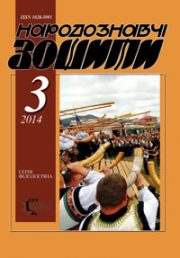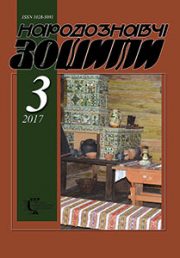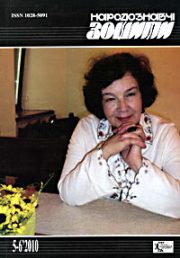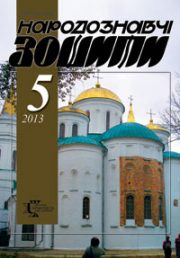The Ethnology Notebooks. 2018, 1 (139), 200–205
UDK 39:35.071.51](477-22)
DOI https://doi.org/10.15407/nz2018.01.200
Received 21.12.2017
Fainyk Tetiana, candidate of sciences in history,
Ph.D, research fellow in the department of the modern ethnology,
of the Institute of Ethnology
of the National Academy of Sciences of Ukraine
Svobody Avenue 15, 79000, Lviv, Ukraine.
Contacts: e-mail: ina@mail.lviv.ua
Abstract. The article deals with the spatial boundary — the boundary between the «our» and «outlying» world in folk ideas; reveals the concept of fencing — to surround space both real and symbolic; it is noted that the creation of a magic circle (fencing with bypass, fumigation, cincture, etc.) is a form of creating obstacles between the supervising object and the bearer of danger.
Keywords: boundary, space, fence, enclose, doorstep, danger, symbol.
REFERENCES
Agapkina, T.A., Valencova, M.M., Levkievskaja, E.E. (2004). Obhodit’. Slavjanskie drevnosti. Jetnolingvisticheskij slovar’: v 5-ti t. (T. 3). Moskva.
Bahniuk, A. (2010). Vorota. Symvoly ukrainstva. Khudozhn’o-informatsijnyj dovidnyk. Ternopil’.
Belova O.V. (2009). Svoj – chuzhoj. Slavjanskie drevnosti. Jetnolingvisticheskij slovar’: v 5-ti t. (T. 4). Moskva.
Vinogradova, L.N., Tolstaja, S.N. (1995). Vorota. Slavjanskie drevnosti. Jetnolingvisticheskij slovar’: v 5-ti t. (T. 1). Moskva.
Vinogradova, L.N., Tolstaja, S.N. (1999). Zabor. Slavjanskie drevnosti. Jetnolingvisticheskij slovar’: v 5-ti t. (T. 2). Moskva.
Hoshko, Yu.H. (1976). Naselennia Ukrains’kykh Karpat XV–XVIII st. Kyiv.
Danyliuk, A. (2004). Narodna arkhitektura Bojkivschyny. L’viv.
Koval’chuk, V.P. (Ed.). (2009). Etnokul’tura Rivnens’koho polissia. Rivne.
Zubryts’kyj, M. (1909). Selians’ki budynky v Mshantsi Starosambirs’koho povitu. Materialy do ukrains’koi etnolohii (T. 2). L’viv: NTSh. P. 1–22.
Ihnatenko, I. (2016). Inter’ier khaty. Sakral’ni mistsia. Etnohrafiia dlia narodu. Kharkiv.
Kobil’nyk, V. (1937). Material’na kul’tura sela Zhukotyna Turchans’koho povitu. Litopys Bojkivschyny. Sambir. № 8.
Levkievskaja, E.E. (2004). Ogorazhivat’. Slavjanskie drevnosti. Jetnolingvisticheskij slovar’: v 5-ti t. (T. 3). Moskva.
Levkievskaja, E.E. (2004). Osvjashhenie. Slavjanskie drevnosti. Jetnolingvisticheskij slovar’: v 5-ti t. (T. 3). Moskva.
Levkievskaja, E.E. (2009). Pojas. Slavjanskie drevnosti. Jetnolingvisticheskij slovar’: v 5-ti t. (T. 4). Moskva.
Plotnikova, A.A. (1999). Dvor. Slavjanskie drevnosti. Jetnolingvisticheskij slovar’: v 5-ti t. (T. 2). Moskva.
Tolstaja, S.M. (2004). Opojasyvanie. Slavjanskie drevnosti. Jetnolingvisticheskij slovar’: v 5-ti t. (T. 3). Moskva.
Ukraintsi: narodni viruvannia, povir’ia, demonolohiia. Kyiv, 1991.
Fajnyk, T. (2007). Zhytlo ta dovkillia: budivel’ni tradytsii ukraintsiv Karpat. L’viv.
Chubyns’kyj, P. (1995). Zhylysche, khoziajstvennye postrojky, orudye y utvar’. Okno. Mudrist’ vikiv: v 2-kh kn. Kyiv. Kn. I.
Chubyns’kyj, P. (1995). Zaklynanye obschee v bolezniakh mladentsev. Mudrist’ vikiv: v 2-kh kn. Kyiv. Kn. I.
Chubyns’kyj, P. (1995). Zemlia. Mudrist’ vikiv: v 2-kh kn. Kyiv. Kn. I.







